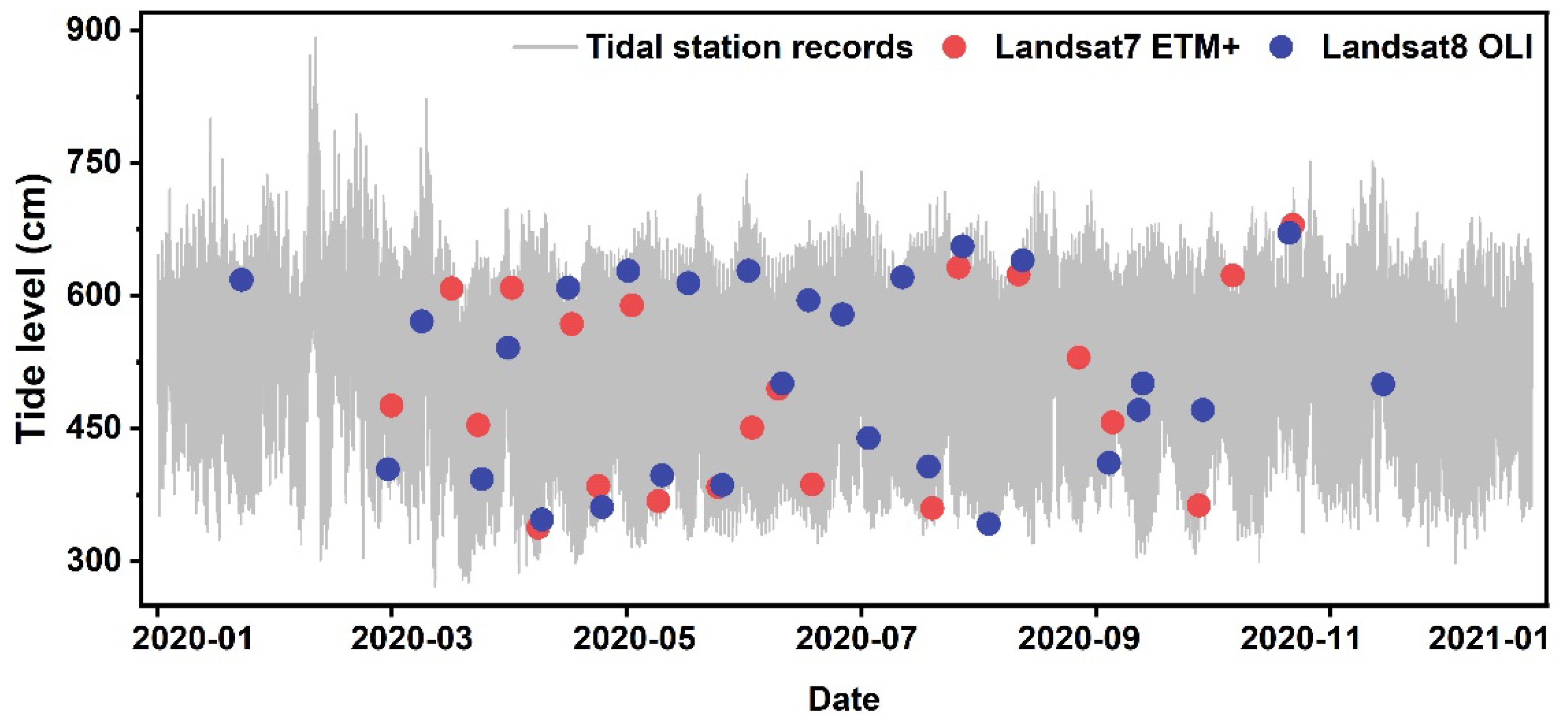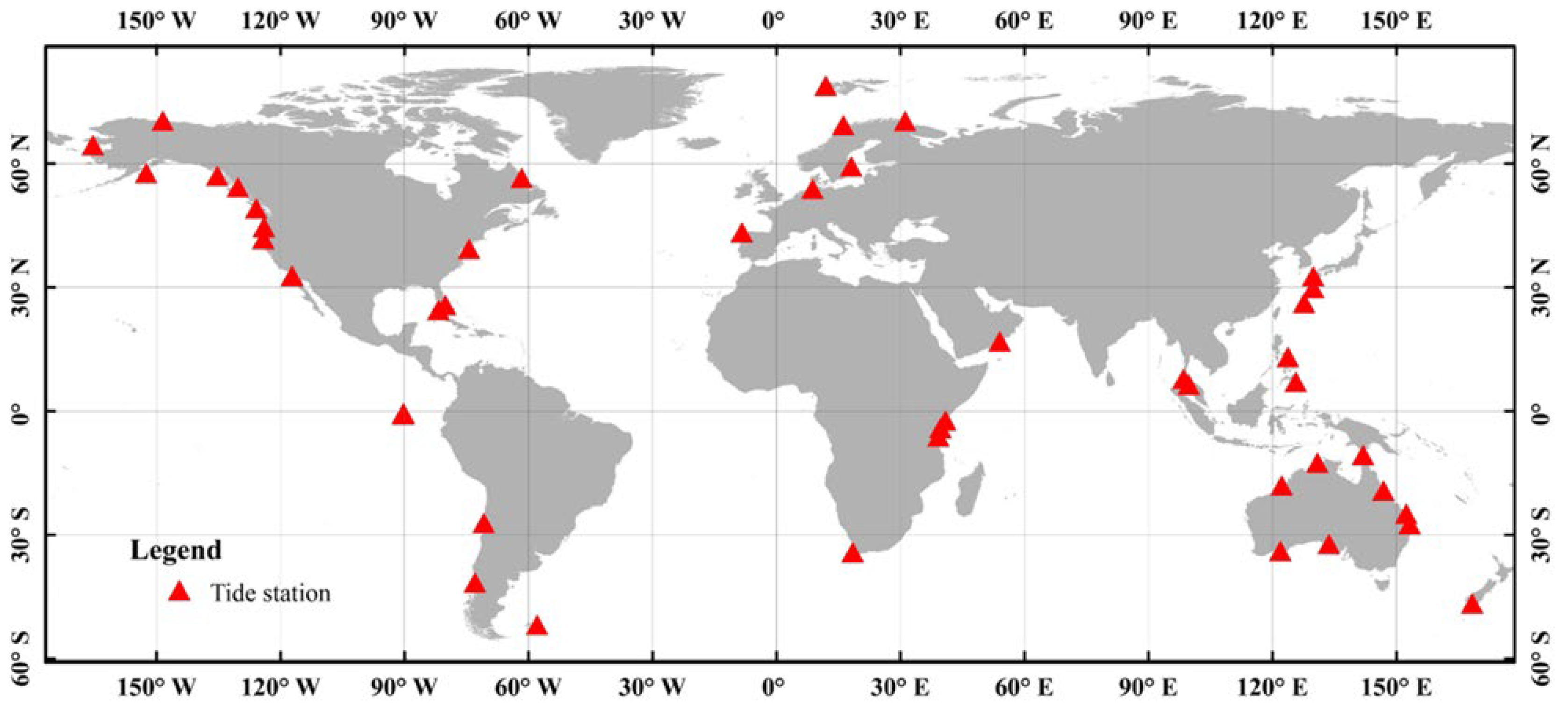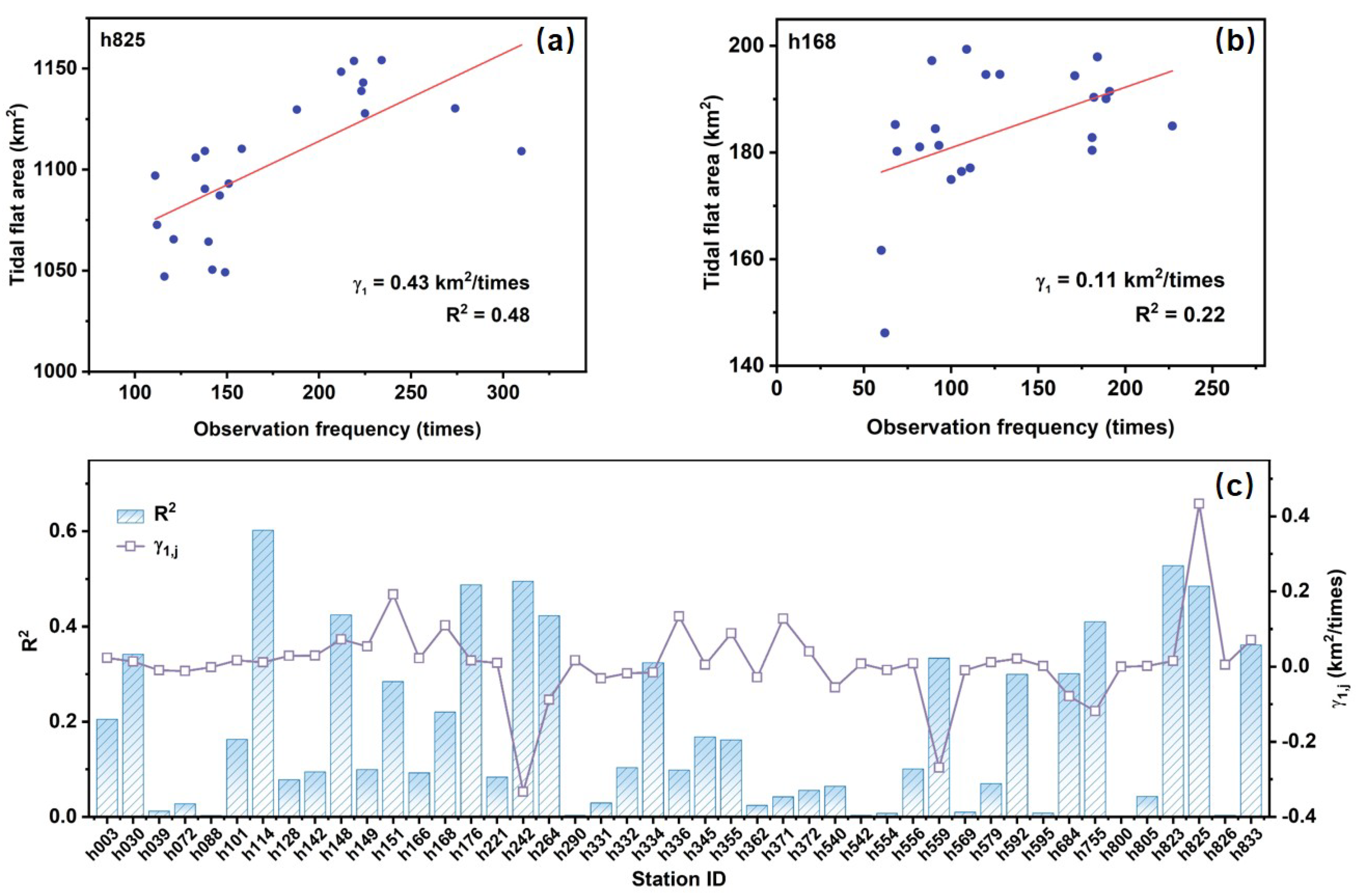Impact of Increased Satellite Observation Frequency on Mapping of Long-Term Tidal Flat Area Changes
Highlights
- A weighted statistical regression approach was proposed to assess the influence of satellite observation frequency on tidal flat mapping.
- Higher observation frequency tends to capture lower tides and larger tidal flat areas.
- Spurious increases of 12.83 ± 6.51 km2 in GTF30 and 13.92 ± 7.45 km2 in Murray’s tidal flats product were found during 2000–2022.
- Substantial inflation effects from increasing observation frequency in long-term tidal flat remote sensing datasets require bias quantification for accurate interpretation of tidal flat dynamics and ecological assessments.
Abstract
1. Introduction
2. Materials and Methods
2.1. Datasets and Preprocessing
2.1.1. Tide Level Observation Dataset
2.1.2. Landsat Data and Tide Levels During Satellite Overpasses
2.1.3. Global Long-Term Tidal Flat Products
2.2. Method
2.2.1. Temporal Trend Analysis of Satellite Observation Frequency and Mapped Tidal Flat Area
2.2.2. Linear Regression Analysis of Satellite Observation Frequency, Tide Level at Satellite Overpass and Tidal Flat Area
2.2.3. Quantifying the Impact of Satellite Observation Frequency on the Mapped Tidal Flat Area at the Global Scale
3. Results
3.1. Trend of Tidal Flat Area Changes
3.2. The Relationship Among Observation Frequency, Tide Level, and Tidal Flat Area
3.3. The Relationship Between Observation Frequency and Tidal Flat Area
4. Discussion
4.1. Uncertainty in the Algorithm Principle of Tidal Flat Products
4.2. Uncertainty in the Satellite-Captured Tide Level
5. Conclusions
Author Contributions
Funding
Data Availability Statement
Acknowledgments
Conflicts of Interest
References
- Brockmann, C.; Stelzer, K. Optical Remote Sensing of Intertidal Flats. In Remote Sensing of the European Seas; Barale, V., Gade, M., Eds.; Springer: Dordrecht, The Netherlands, 2008; pp. 117–128. [Google Scholar]
- Barbier, E.B.; Koch, E.W.; Silliman, B.R.; Hacker, S.D.; Wolanski, E.; Primavera, J.; Granek, E.F.; Polasky, S.; Aswani, S.; Cramer, L.A.; et al. Coastal Ecosystem-Based Management with Nonlinear Ecological Functions and Values. Science 2008, 319, 321–323. [Google Scholar] [CrossRef] [PubMed]
- Bell, P.S.; Bird, C.O.; Plater, A.J. A temporal waterline approach to mapping intertidal areas using X-band marine radar. Coast. Eng. 2016, 107, 84–101. [Google Scholar] [CrossRef]
- Murray, N.J.; Clemens, R.S.; Phinn, S.R.; Possingham, H.P.; Fuller, R.A. Tracking the rapid loss of tidal wetlands in the Yellow Sea. Front. Ecol. Environ. 2014, 12, 267–272. [Google Scholar] [CrossRef]
- Murray, N.J.; Phinn, S.P.; Fuller, R.A.; DeWitt, M.; Ferrari, R.; Johnston, R.; Clinton, N.; Lyons, M.B. High-resolution global maps of tidal flat ecosystems from 1984 to 2019. Sci. Data 2022, 9, 123–138. [Google Scholar] [CrossRef] [PubMed]
- Murray, N.J.; Phinn, S.R.; DeWitt, M.; Ferrari, R.; Johnston, R.; Lyons, M.B.; Clinton, N.; Thau, D.; Fuller, R.A. The global distribution and trajectory of tidal flats. Nature 2019, 565, 222–225. [Google Scholar] [CrossRef]
- Zhang, X.; Liu, L.Y.; Wang, J.Q.; Zhao, T.T.; Liu, W.D.; Chen, X.D. Automated Mapping of Global 30-m Tidal Flats Using Time-Series Landsat Imagery: Algorithm and Products. J. Remote Sens. 2023, 3, 0091. [Google Scholar] [CrossRef]
- Cao, W.; Zhou, Y.; Li, R.; Li, X. Mapping changes in coastlines and tidal flats in developing islands using the full time series of Landsat images. J. Remote Sens. Environ. 2020, 239, 111665. [Google Scholar] [CrossRef]
- Zhang, M.; Lang, Z.; Liu, Y. Variation mechanisms of suspended sediment concentration in complex estuary determined through remote sensing, observation and modeling coupling. J. Int. J. Appl. Earth Obs. Geoinf. 2025, 139, 104539. [Google Scholar] [CrossRef]
- Xu, C.; Liu, W. Mapping and analyzing the annual dynamics of tidal flats in the conterminous United States from 1984 to 2020 using Google Earth Engine. Environ. Adv. 2022, 7, 100147. [Google Scholar] [CrossRef]
- Murray, N.J.; Worthington, T.A.; Bunting, P.; Duce, S.; Hagger, V.; Lovelock, C.E.; Lucas, R.; Saunders, M.I.; Sheaves, M.; Spalding, M.; et al. High-resolution mapping of losses and gains of Earth’s tidal wetlands. Science 2022, 376, 744–749. [Google Scholar] [CrossRef]
- Wulder, M.A.; Masek, J.G.; Cohen, W.B.; Loveland, T.R.; Woodcock, C.E. Opening the archive: How free data has enabled the science and monitoring promise of Landsat. Remote Sens. Environ. 2012, 122, 2–10. [Google Scholar] [CrossRef]
- Zhao, B.X.; Liu, Y.X.; Wang, L.; Liu, Y.C.; Sun, C.; Fagherazzi, S. Stability evaluation of tidal flats based on time-series satellite images: A case study of the Jiangsu central coast, China. Estuar. Coastal Shelf Sci. 2022, 264, 107697. [Google Scholar] [CrossRef]
- Xu, N.; Wang, L.; Xu, H.; Ma, Y.; Li, Y.; Wang, X.H. Deriving Accurate Intertidal Topography for Sandy Beaches Using ICESat-2 Data and Sentinel-2 Imagery. J. Remote Sens. 2024, 4, 0305. [Google Scholar] [CrossRef]
- Allen, G.H.; Yang, X.; Gardner, J.; Holliman, J.; David, C.H.; Ross, M. Timing of Landsat Overpasses Effectively Captures Flow Conditions of Large Rivers. Remote Sens. 2020, 12, 1510. [Google Scholar] [CrossRef]
- Jia, M.; Wang, Z.; Mao, D.; Ren, C.; Wang, C.; Wang, Y. Rapid, robust, and automated mapping of tidal flats in China using time series Sentinel-2 images and Google Earth Engine. Remote Sens. Environ. 2021, 255, 112285. [Google Scholar] [CrossRef]
- Zhang, Z.; Xu, N.; Li, Y.; Li, Y. Sub-continental-scale mapping of tidal wetland composition for East Asia: A novel algorithm integrating satellite tide-level and phenological features. Remote Sens. Environ. 2022, 269, 112799. [Google Scholar] [CrossRef]
- Wang, X.; Xiao, X.; Zou, Z.; Hou, L.; Qin, Y.; Dong, J.; Doughty, R.B.; Chen, B.; Zhang, X.; Chen, Y.; et al. Mapping coastal wetlands of China using time series Landsat images in 2018 and Google Earth Engine. ISPRS J. Photogramm. Remote Sens. 2020, 163, 312–326. [Google Scholar] [CrossRef]
- Zhang, Y.T.; Woodcock, C.E.; Arevalo, P.; Olofsson, P.; Tang, X.J.; Stanimirova, R.; Bullock, E.; Tarrio, K.R.; Zhu, Z.; Friedl, M.A. A Global Analysis of the Spatial and Temporal Variability of Usable Landsat Observations at the Pixel Scale. Front. Remote Sens. 2022, 3, 894618. [Google Scholar] [CrossRef]
- Zhou, Y.; Dong, J.; Liu, J.; Metternicht, G.; Shen, W.; You, N.; Zhao, G.; Xiao, X. Are There Sufficient Landsat Observations for Retrospective and Continuous Monitoring of Land Cover Changes in China? Remote Sens. 2019, 11, 1808. [Google Scholar] [CrossRef]
- Zhang, X.; Liu, L.Y.; Zhao, T.T.; Gao, Y.; Chen, X.D.; Mi, J. GISD30: Global 30 m impervious-surface dynamic dataset from 1985 to 2020 using time-series Landsat imagery on the Google Earth Engine platform. Earth Syst. Sci. Data 2022, 14, 1831–1856. [Google Scholar] [CrossRef]
- Wulder, M.A.; Loveland, T.R.; Roy, D.P.; Crawford, C.J.; Masek, J.G.; Woodcock, C.E.; Allen, R.G.; Anderson, M.C.; Belward, A.S.; Cohen, W.B.; et al. Current status of Landsat program, science, and applications. Remote Sens. Environ. 2019, 225, 127–147. [Google Scholar] [CrossRef]
- Bayle, A.; Gascoin, S.; Berner, L.T.; Choler, P. Landsat-based greening trends in alpine ecosystems are inflated by multidecadal increases in summer observations. Ecography 2024, 2024, 12. [Google Scholar] [CrossRef]
- Zhang, X.; Zhao, T.; Xu, H.; Liu, W.; Wang, J.; Chen, X.; Liu, L. GLC_FCS30D: The first global 30 m land-cover dynamics monitoring product with a fine classification system for the period from 1985 to 2022 generated using dense-time-series Landsat imagery and the continuous change-detection method. Earth Syst. Sci. Data 2024, 16, 1353–1381. [Google Scholar] [CrossRef]
- Zhu, Z.; Woodcock, C.E. Automated cloud, cloud shadow, and snow detection in multitemporal Landsat data: An algorithm designed specifically for monitoring land cover change. Remote Sens. Environ. 2014, 152, 217–234. [Google Scholar] [CrossRef]
- Zhang, X.; Liu, L.; Zhao, T.; Wang, J.; Liu, W.; Chen, X. Global annual wetland dataset at 30 m with a fine classification system from 2000 to 2022. Sci. Data 2024, 11, 310. [Google Scholar] [CrossRef]
- Ray, R.D. Precise comparisons of bottom-pressure and altimetric ocean tides. J. Geophys. Res. Oceans 2013, 118, 4570–4584. [Google Scholar] [CrossRef]
- Thompson, P.R.; Mitchum, G.T. Coherent sea level variability on the North Atlantic western boundary. J. Geophys. Res. Oceans 2014, 119, 5676–5689. [Google Scholar] [CrossRef]
- Guo, L.; van der Wegen, M.; Wang, Z.B.; Roelvink, D.; He, Q. Exploring the impacts of multiple tidal constituents and varying river flow on long-term, large-scale estuarine morphodynamics by means of a 1-D model. J. Geophys. Res. Earth Surf. 2016, 121, 1000–1022. [Google Scholar] [CrossRef]
- Niven, E.B.; Deutsch, C.V. Calculating a robust correlation coefficient and quantifying its uncertainty. Comput. Geosci. 2012, 40, 1–9. [Google Scholar] [CrossRef]
- Farrance, I.; Frenkel, R. Uncertainty of Measurement: A Review of the Rules for Calculating Uncertainty Components through Functional Relationships. Clin. Biochem. Rev. 2012, 33, 49–75. [Google Scholar]
- Ma, S.; Wang, N.; Zhou, L.; Yu, J.; Chen, X.; Chen, Y. Inversion of Tidal Flat Topography Based on the Optimised Inundation Frequency Method—A Case Study of Intertidal Zone in Haizhou Bay, China. Remote Sens. 2024, 16, 685. [Google Scholar] [CrossRef]
- Chang, M.; Li, P.; Li, Z.; Wang, H. Mapping Tidal Flats of the Bohai and Yellow Seas Using Time Series Sentinel-2 Images and Google Earth Engine. Remote Sens. 2022, 14, 1789. [Google Scholar] [CrossRef]
- D’Alpaos, A.; Tognin, D.; Tommasini, L.; D’Alpaos, L.; Rinaldo, A.; Carniello, L. Statistical characterization of erosion and sediment transport mechanics in shallow tidal environments—Part 1: Erosion dynamics. Earth Surf. Dynam. 2024, 12, 181–199. [Google Scholar] [CrossRef]
- Wu, W.; Lin, Z.; Chen, C.; Chen, Z.; Zhao, Z.; Su, H. Tracking the dynamics of tidal wetlands with time-series satellite images in the Yangtze River Estuary, China. Int. J. Digit. Earth 2024, 17, 2330684. [Google Scholar] [CrossRef]
- Luan, K.; Wan, H.-F.; Wang, Z.; Lu, X.; Bei, Z.; Yuan, J.; Cao, Z.; You, X.; Wang, J.; Shen, W.; et al. Mapping of Yangtze River Estuary Tidal Flat Based on Sentinel-2 Sensor and Google Earth Engine. Sens. Mater. 2024, 36, 2983–3000. [Google Scholar] [CrossRef]
- Kim, K.; Jung, H.C.; Choi, J.-K.; Ryu, J.-H. Statistical Analysis for Tidal Flat Classification and Topography Using Multitemporal SAR Backscattering Coefficients. Remote Sens. 2021, 13, 5169. [Google Scholar] [CrossRef]
- Pricope, N.G.; Halls, J.N.; Dalton, E.G.; Minei, A.; Chen, C.; Wang, Y. Precision Mapping of Coastal Wetlands: An Integrated Remote Sensing Approach Using Unoccupied Aerial Systems Light Detection and Ranging and Multispectral Data. J. Remote Sens. 2024, 4, 169. [Google Scholar] [CrossRef]










Disclaimer/Publisher’s Note: The statements, opinions and data contained in all publications are solely those of the individual author(s) and contributor(s) and not of MDPI and/or the editor(s). MDPI and/or the editor(s) disclaim responsibility for any injury to people or property resulting from any ideas, methods, instructions or products referred to in the content. |
© 2025 by the authors. Licensee MDPI, Basel, Switzerland. This article is an open access article distributed under the terms and conditions of the Creative Commons Attribution (CC BY) license (https://creativecommons.org/licenses/by/4.0/).
Share and Cite
Wang, J.; Zhang, X.; Zhao, T.; Liu, L. Impact of Increased Satellite Observation Frequency on Mapping of Long-Term Tidal Flat Area Changes. Remote Sens. 2025, 17, 3656. https://doi.org/10.3390/rs17213656
Wang J, Zhang X, Zhao T, Liu L. Impact of Increased Satellite Observation Frequency on Mapping of Long-Term Tidal Flat Area Changes. Remote Sensing. 2025; 17(21):3656. https://doi.org/10.3390/rs17213656
Chicago/Turabian StyleWang, Jinqing, Xiao Zhang, Tingting Zhao, and Liangyun Liu. 2025. "Impact of Increased Satellite Observation Frequency on Mapping of Long-Term Tidal Flat Area Changes" Remote Sensing 17, no. 21: 3656. https://doi.org/10.3390/rs17213656
APA StyleWang, J., Zhang, X., Zhao, T., & Liu, L. (2025). Impact of Increased Satellite Observation Frequency on Mapping of Long-Term Tidal Flat Area Changes. Remote Sensing, 17(21), 3656. https://doi.org/10.3390/rs17213656






